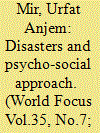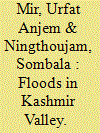| Srl | Item |
| 1 |
ID:
161244


|
|
|
|
|
| Summary/Abstract |
With the beginning of anthropocene, the question of sustainability and the challenges it is faced with become critical for human survival in the debate on nature and environmental protection. In this background, few challenges for sustainability are discussed in this paper, especially what may help in striving for sustainable human – nature interactions. Can there be single framework of sustainability and what are its determinants? Can sustainability be ever achieved given the present economic growth pursuit and the social consumerist behaviour of humans across societies and globe? Should the efforts of protecting environment and nature primarily target at achieving sustainability in the contemporary times or vice versa?
|
|
|
|
|
|
|
|
|
|
|
|
|
|
|
|
| 2 |
ID:
132499


|
|
|
|
|
| Publication |
2014.
|
| Summary/Abstract |
Disasters both manmade as well as natural often result in great physical and material loss for the affected communities, besides affecting the social, physical and psychological well-being of the survivors in its aftermath. It has been seen that disasters have an adverse impact on the survival, dignity and livelihoods of individuals and communities, particularly of the poor, in both developed and less developed countries. There are multiple factors which have been attributed as causes of these extreme events, like environmentally unsound practices, global climatic changes, population growth, urbanization, social injustice, poverty etc. However, when it comes to comprehension of disasters in contemporary times, there is a need to look at disaster as social phenomena. This is precisely, with regard to man- nature relationship discourse. While explaining this relationship, Kroeber (1939 p1), rightly writes, ' while it is true that cultures are rooted in nature, and can therefore never be understood except with reference to that piece of nature in which they occur, they are no more produced by that nature thana plant" is produced or caused by the soil in which it is rooted. The immediate causes of cultural phenomena are other cultural phenomena.
|
|
|
|
|
|
|
|
|
|
|
|
|
|
|
|
| 3 |
ID:
145388


|
|
|
|
|
| Summary/Abstract |
Drury and Oslon (1997, 1998) found a relationship between natural disasters and political unrest and the variables such as insufficient and inequitable government response and the severity of the disaster. It has been further found in few studies conducted by various scholars that vulnerabilities created by natural disasters can be exploited by rebel groups; droughts increase civil war in Africa and that natural disasters increase the risk of violent civil conflict in the short and medium term in low and middle income countries.
|
|
|
|
|
|
|
|
|
|
|
|
|
|
|
|
| 4 |
ID:
148010


|
|
|
|
|
| Summary/Abstract |
The aim of this article is to underscore the global climate change impact and the beginning of anthropocene by looking at the human – environment relationship through the anthropological perspective. By using a cultural approach to the study of human–nature relationship, the aim is not only to understand the circumstances leading to anthropocene but also to touch upon the nuances of environmentalism and sustainable development debate in contemporary times.
|
|
|
|
|
|
|
|
|
|
|
|
|
|
|
|
| 5 |
ID:
145390


|
|
|
|
|
| Summary/Abstract |
Ladakh, the high altitude desert, normally used to receive lots of snow fall in winter and very less rains in summer. Most of the villages in Ladakh depend on the snow and glaciers melted water for their agricultures and drinking. But the victims shared that it slowly was changing and less snow fall in winter and more rains in summer were being experienced.
|
|
|
|
|
|
|
|
|
|
|
|
|
|
|
|